All products featured are independently chosen by us. However, SoundGuys may receive a commission on orders placed through its retail links. See our ethics statement.
Bose QuietComfort Ultra Headphones (2nd Gen) vs QuietComfort Ultra Headphones: Should you upgrade?
October 3, 2025
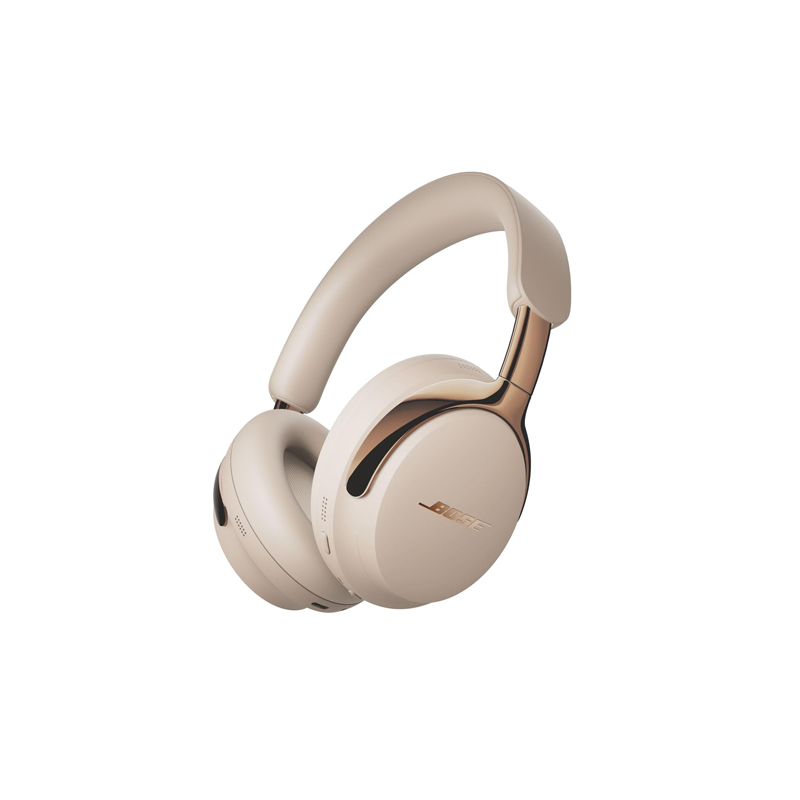

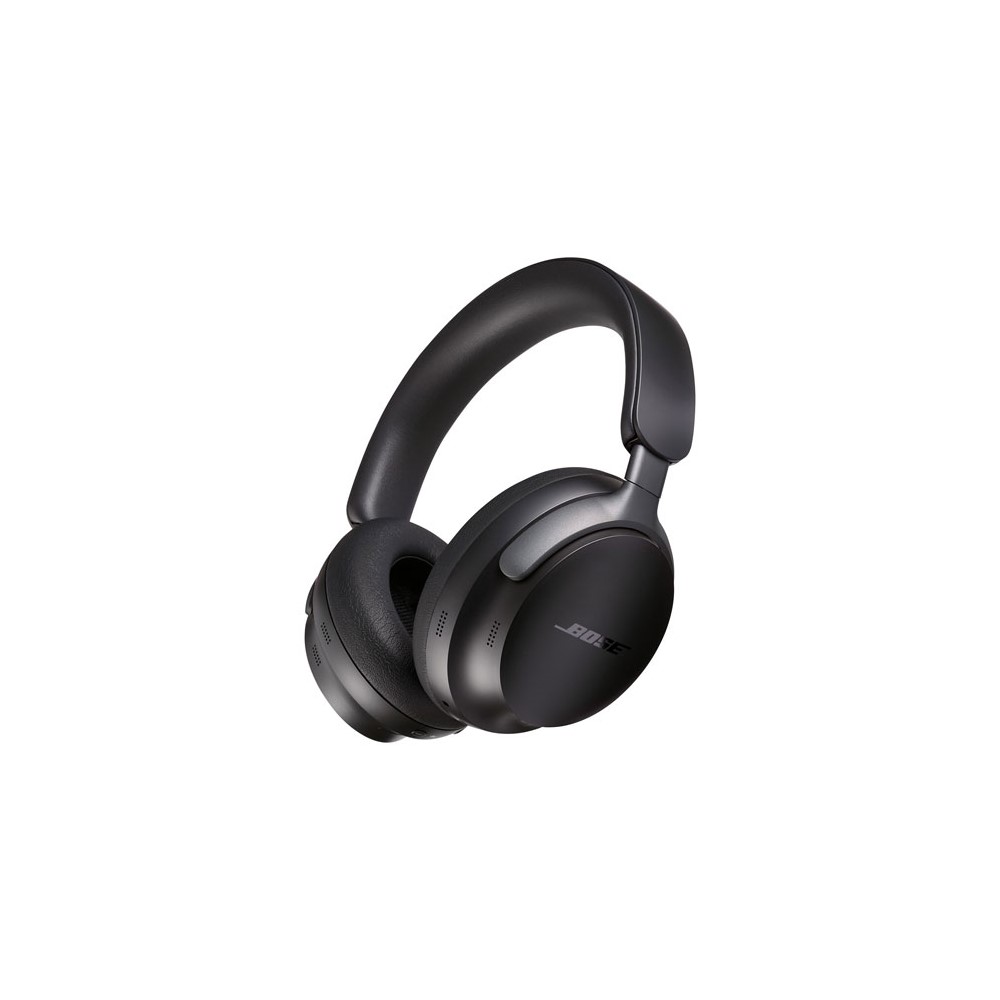
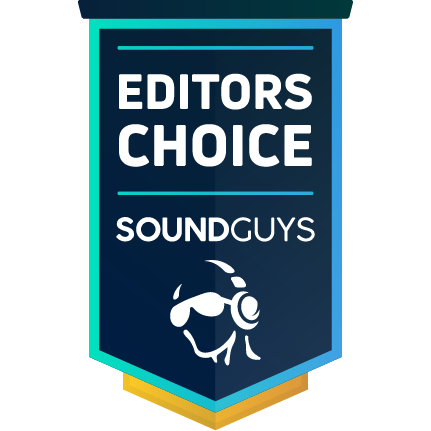
Bose has been the go-to name in noise canceling headphones for years, and now we’ve got two versions of its Ultra line to consider: the 2023 original Bose QuietComfort Ultra Headphones, and the refreshed 2nd Gen in 2025. At first glance, they look nearly identical, which raises the obvious question: does the newer model actually add anything meaningful?
After testing both side by side, I found plenty of similarities, but also a few differences worth noting. Let’s take a closer look.
This article was originally published on October 3rd, 2025, and this is the first version.
What’s it like to use the Bose QuietComfort Ultra (2nd Gen) compared to the Bose QuietComfort Ultra?
Both headphones follow the familiar Bose QC blueprint: lightweight plastic construction, a padded headband and earcups, and angled drivers for added comfort. Weighing just 253g, the original Ultra set a high bar for long-term comfort—especially for glasses wearers. The 2nd Gen feels similarly light on the head, though I noticed slightly more ear contact with the padding, which could be a concern for listeners with larger ears.
Build quality is nearly identical between the two, and neither model carries an IP rating—so they’re best kept away from rain or sweaty workouts. Both fold flat and come with a sturdy zippered case. However, the 2nd Gen introduces a “lay flat to pause” feature that can occasionally cause battery drain if the headphones aren’t folded correctly. Control schemes remain consistent across both versions: a multifunction button, a power/Bluetooth button, and a touch-sensitive strip for volume
Do the Bose QuietComfort Ultra (2nd Gen) or Bose QuietComfort Ultra have more features?
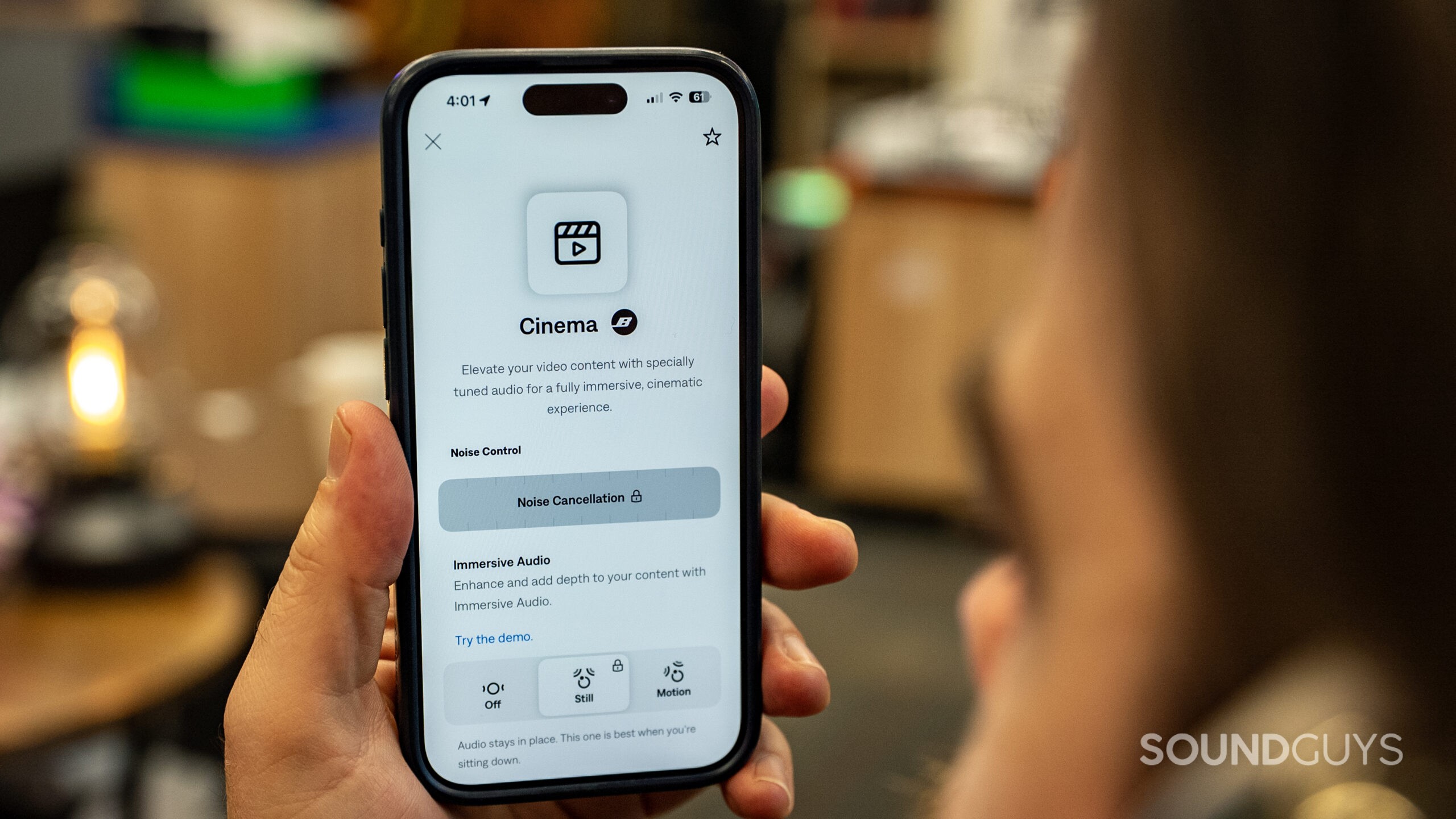
Neither pair breaks new ground in app support, but the 2nd Gen adds some polish with updated software. Most notably, it introduces a new Cinema mode that aims to simulate surround sound for movies. I didn’t find it especially convincing—much like Bose’s earlier Immersive modes—but some listeners might enjoy the added effect.
Both models pair with the Bose Music app, offering EQ controls, ANC adjustments, and user presets. Still, the EQ is fairly limited. If you want granular control, look elsewhere. The 3-band EQ—Bass, Mid, and Treble—is fine for light tuning but won’t satisfy anyone who likes to dial in their sound with precision.
CustomTune remains the highlight. It automatically calibrates the sound to your ears at startup, and both pairs support it. That personalization helps ensure the audio profile stays consistent from listener to listener, and it’s a big part of why these headphones sound so balanced out of the box.
How do the Bose QuietComfort Ultra (2nd Gen) and Bose QuietComfort Ultra connect?
This is where the 2nd Gen starts to pull ahead. The original Ultra supports Bluetooth 5.3 with SBC, AAC, and aptX Adaptive (including aptX Lossless), plus analog input via a 2.5mm to 3.5mm cable. However, its USB-C port is limited to charging—there’s no digital audio over USB-C.
The 2nd Gen upgrades to Bluetooth 5.4 and finally adds USB-C audio with full lossless support, alongside SBC, AAC, and the aptX Adaptive family. This combination of inputs makes it much more accommodating for modern devices.
Is battery life better on the Bose QuietComfort Ultra (2nd Gen) or Bose QuietComfort Ultra?
Battery life is a tie—both pairs lasted around 27 hours in our standardized test, which easily covers multiple days of use or a long-haul flight.
Fast charging is available on both models: 15 minutes of charging yields a couple of hours of playback. The 2nd Gen doesn’t improve on this, but it doesn’t fall behind either.
Do the Bose QuietComfort Ultra (2nd Gen) or Bose QuietComfort Ultra block noise better?
Loading chart ...
Noise cancelation remains Bose’s crown jewel. Both headphones do an excellent job cutting engine rumble, office chatter, and street noise. The original Ultra reduced real-world external noise by around 87% in our testing, and the 2nd Gen maintains similarly strong performance.
Bose claims the 2nd Gen’s ANC is “more precise,” though in practice, I didn’t notice a dramatic difference in overall attenuation. What I did feel was the infamous “eardrum suck” on the 2nd Gen — a sign of just how aggressively it operates. Both models also feature strong passthrough modes, with the 2nd Gen’s ActiveSense taking care sudden loud noises.
Do the Bose QuietComfort Ultra (2nd Gen) sound better than the Bose QuietComfort Ultra?
Both versions of the Bose QuietComfort Ultra Headphones stick to a similar tuning: strong bass strength, bright treble, and a recessed midrange. That combo works well for pop, electronic, and anything with heavy production — the low-end has plenty of punch, and the added brilliance helps everything sparkle a bit. But if you mostly listen to podcasts or vocal-heavy content, you’ll probably want to tweak the EQ to bring back some midrange clarity.
That said, the original QuietComfort Ultra pushes this tuning even further. It has noticeably more boomy bass, even less midrange strength, and a sharp treble peak around 8kHz. That spike can come across as shrill or sibilant depending on what you’re listening to — not a dealbreaker, but definitely something to keep in mind if you’re sensitive to treble.
Multi-Dimensional Audio Quality Scores (MDAQS)
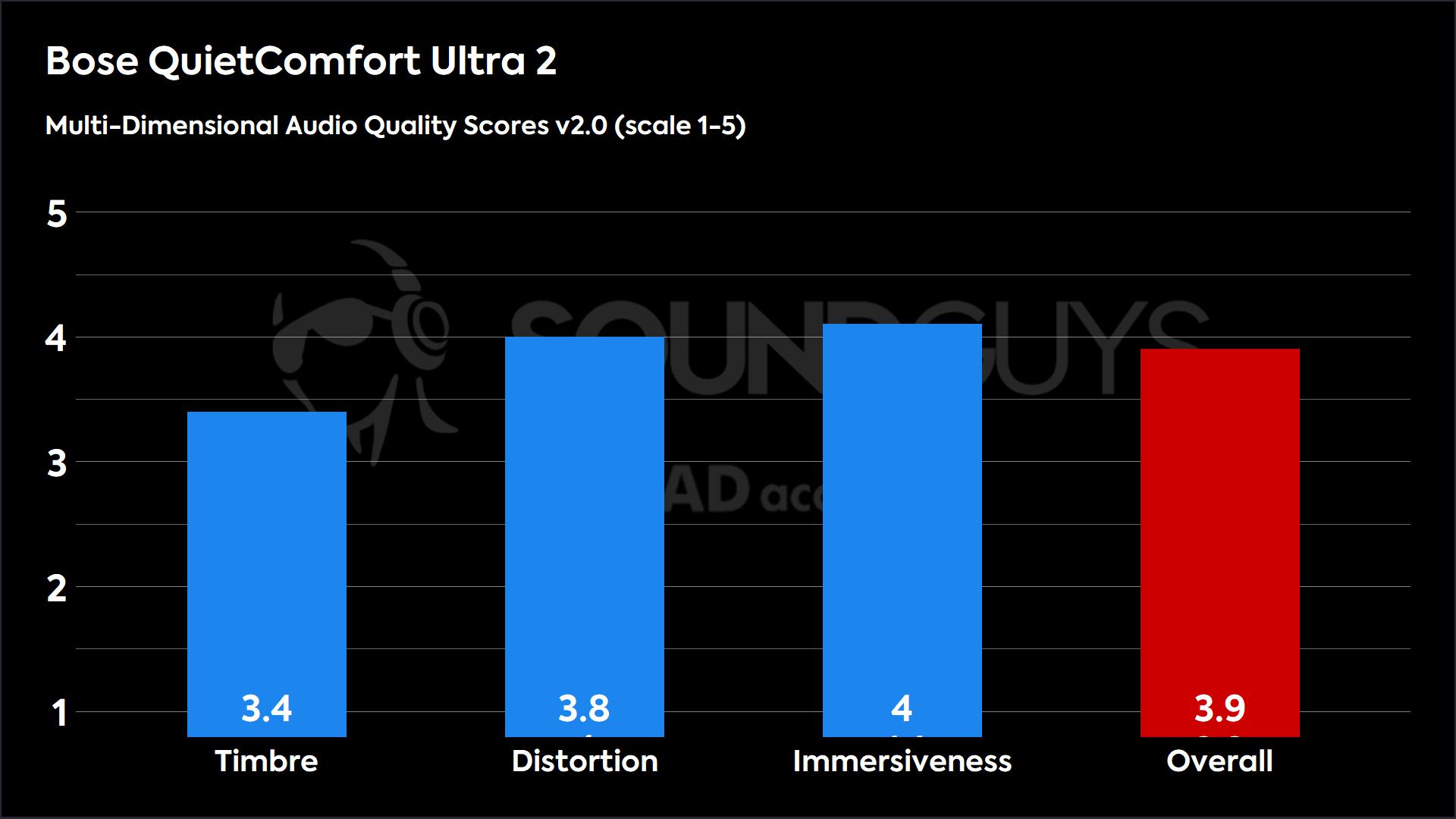
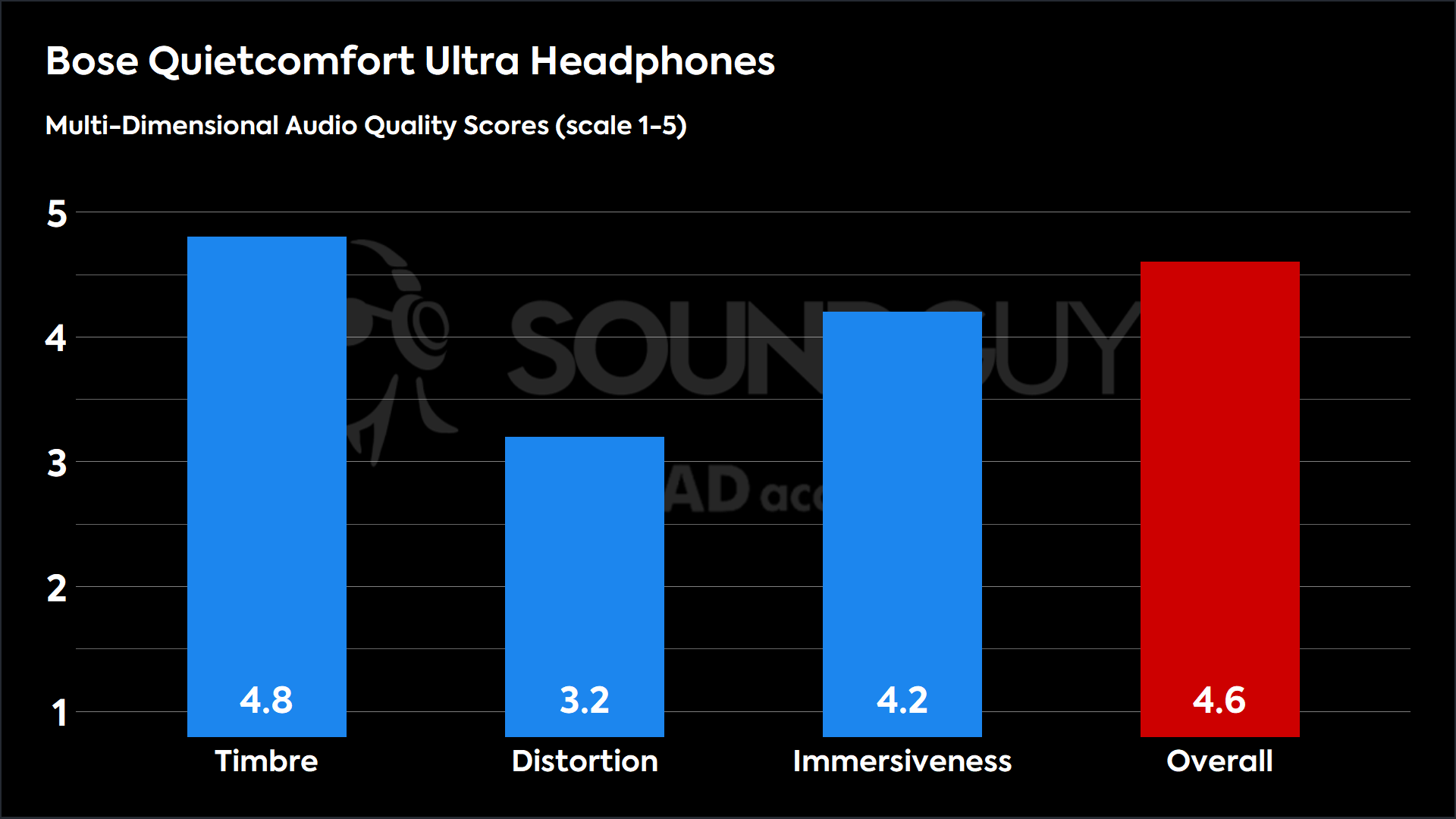
Hold up! Something’s different. The Multi-Dimensional Audio Quality Scores for the Bose QuietComfort Ultra (2nd Gen) and Bose QuietComfort Ultra are not directly comparable due to a version difference between each reading. We’re still crunching the numbers on all of our previous samples to rectify this inconsistency soon.
- Timbre (MOS-T) represents how faithfully the headphones reproduce the frequency spectrum and temporal resolution (timing information).
- Distortion (MOS-D) represents non-linearities and added noise: higher scores mean cleaner reproduction.
- Immersiveness (MOS-I) represents perceived source width and positioning: how well virtual sound sources are defined in three-dimensional space.
Objective Measurements
Loading chart ...
Both versions of the Bose QuietComfort Ultra generally follow our SoundGuys Headphone Preference Curve, but with some clear differences. They boost the bass more than our curve suggests, which gives music plenty of punch but can sound boomy at times.
The 2nd Gen sticks closer to the curve in the mids and treble, so vocals and instruments sound a bit more natural. The original Ultra dips more in the midrange and has a sharp treble peak around 8kHz, which can make some high-frequency sounds feel harsh. Overall, the 2nd Gen stays truer to our preferred tuning and offers a more balanced sound.
Do the Bose QuietComfort Ultra (2nd Gen) or Bose QuietComfort Ultra have a better microphone?
Both headphones use multi-mic arrays with strong noise reduction. In quiet environments, voices come through clearly. In noisy streets or windy conditions, incidental noise is reduced effectively, though sometimes at the cost of natural vocal tone.
The 2023 Ultra’s microphone scored higher in user testing, with over 70% of listeners rating it “good” or “perfect.” The 2nd Gen mic is competent, but user polls showed more mixed reactions, suggesting the first-gen may hold a slight edge.
Listen to how each mic handles ideal and windy conditions in the clips below.
Bose QuietComfort Ultra (2nd Gen) microphone demo (Ideal conditions):
Bose QuietComfort Ultra microphone demo (Ideal conditions):
Bose QuietComfort Ultra (2nd Gen) microphone demo (Windy conditions):
Bose QuietComfort Ultra microphone demo (Windy conditions):
Which microphone sounds better to you?
Bose QuietComfort Ultra (2nd Gen) vs Bose QuietComfort Ultra: Price and availability
-
Bose QuietComfort Ultra Headphones (2nd Gen): Released September 2025 at $449.99
-
Bose QuietComfort Ultra Headphones (2023): Released November 2023 at $429
With only a $20 gap, price isn’t a major differentiator. The real decision comes down to features.
Should you get the Bose QuietComfort Ultra (2nd Gen) or Bose QuietComfort Ultra?
Buy the 2nd Gen if you’re new to the Ultra line — skip it if you already own the 2023 version.
If you want the most versatile and future-proof option, the Bose QuietComfort Ultra Headphones (2nd Gen) make more sense. USB-C audio and Bluetooth 5.4 give them an edge for modern devices, and ANC remains best-in-class.
However, if you already own the original 2023 Ultra, there’s little reason to upgrade. The improvements are incremental at best, and the 2nd Gen’s sound tweaks — including slightly more upper-mid variation — may not be to everyone’s taste. In fact, you might prefer the more consistent tuning of the original.
At just a $20 difference, the 2nd Gen is clearly the better buy for first-time shoppers. But if you’ve already got the first-gen Ultra, you’re not missing out on much — stick with what you have.

Good ANC
USB-C lossless
Price
Which headphones would you buy?
Which headphones would you buy?
Thank you for being part of our community. Read our Comment Policy before posting.